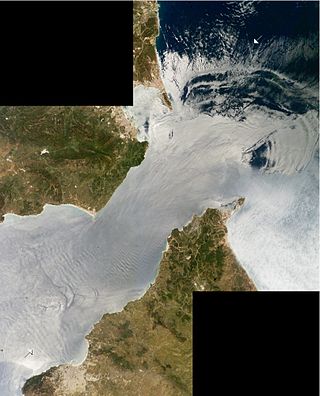
The Indian prawn is one of the major commercial prawn species of the world. It is found in the Indo-West Pacific from eastern and south-eastern Africa, through India, Malaysia and Indonesia to southern China and northern Australia. Adult shrimp grow to a length of about 22 cm (9 in) and live on the seabed to depths of about 90 m (300 ft). The early developmental stages take place in the sea before the larvae move into estuaries. They return to the sea as sub-adults.

Internal waves are gravity waves that oscillate within a fluid medium, rather than on its surface. To exist, the fluid must be stratified: the density must change with depth/height due to changes, for example, in temperature and/or salinity. If the density changes over a small vertical distance, the waves propagate horizontally like surface waves, but do so at slower speeds as determined by the density difference of the fluid below and above the interface. If the density changes continuously, the waves can propagate vertically as well as horizontally through the fluid.
Sorberacea were a monoorder and monofamilial class of benthic Tunicates. The single order of the class was Aspiraculata, and the single family of that order was Hexacrobylidae. In a taxonomic revision of the Tunicata in 2007, the name "Hexacrobylidae" was declared invalid and members of the family were included in the family Molgulidae in the class Ascidiacea.

Ekman transport is part of Ekman motion theory, first investigated in 1902 by Vagn Walfrid Ekman. Winds are the main source of energy for ocean circulation, and Ekman transport is a component of wind-driven ocean current. Ekman transport occurs when ocean surface waters are influenced by the friction force acting on them via the wind. As the wind blows it casts a friction force on the ocean surface that drags the upper 10-100m of the water column with it. However, due to the influence of the Coriolis effect, the ocean water moves at a 90° angle from the direction of the surface wind. The direction of transport is dependent on the hemisphere: in the northern hemisphere, transport occurs at 90° clockwise from wind direction, while in the southern hemisphere it occurs at 90° anticlockwise. This phenomenon was first noted by Fridtjof Nansen, who recorded that ice transport appeared to occur at an angle to the wind direction during his Arctic expedition of the 1890s. Ekman transport has significant impacts on the biogeochemical properties of the world's oceans. This is because it leads to upwelling and downwelling in order to obey mass conservation laws. Mass conservation, in reference to Ekman transfer, requires that any water displaced within an area must be replenished. This can be done by either Ekman suction or Ekman pumping depending on wind patterns.
Thermodesulfobacterium hydrogeniphilum is a species of Sulfate-reducing bacteria. It is thermophilic, chemolithoautotrophic, non-spore-forming, marine species, with type strain SL6T.
Nitratireductor aquibiodomus is a Gram-negative, rod-shaped bacteria from the genus of Nitratireductor which was isolated from a marine denitrification system in Canada.
Nitratireductor aquimarinus is a Gram-negative, aerobic bacteria from the genus of Nitratireductor which was isolated from Skeletonema costatum from the Sea of Japan.
Nitratireductor basaltis is a Gram-negative, oxidase- and catalase-positive bacteria from the genus of Nitratireductor which was isolated from black sand from the Soesoggak beach on the Jeju Island in South Korea.
Nitratireductor kimnyeongensis is a Gram-negative, aerobic, oxidase- and catalase-positive bacteria from the genus of Nitratireductor which was isolated from the Kimnyeong Beach in Jeju from the Republic of Korea.
Nitratireductor pacificus is a Gram-negative and motile bacteria from the genus of Nitratireductor which was isolated from enriched sediment from the Pacific Ocean.
Streptomyces indicus is a bacterium species from the genus of Streptomyces which has been isolated from deep sea sediments from the Indian Ocean in India.
Parvibaculum indicum is a Gram-negative, rod-shaped and motile bacterium with a polar flagellum species from the genus of Parvibaculum which has been isolated from deep-sea water from the Indian Ocean.
Novosphingobium indicum is a bacterium from the genus Novosphingobium which has been isolated from deep-sea water from the Indian Ocean. Novosphingobium indicum has the ability to degrade polycyclic aromatic hydrocarbon.
Nitratireductor lacus is a Gram-negative bacteria from the genus of Nitratireductor which has been isolated from the Yuncheng Salt Lake in China.
Calidifontibacter indicus is a Gram-positive and non-motile bacterium from the genus of Calidifontibacter which has been isolated from spring water from the Western Ghats in India.
Celeribacter halophilus is a Gram-negative and non-motile bacterium from the genus of Celeribacter which has been isolated from seawater from the coastal region of Qingdao in China.
Celeribacter indicus is a bacterium from the genus of Celeribacter which has been isolated from deep sea sediments from the Indian Ocean.Celeribacter indicus can degrade polycyclic aromatic hydrocarbons.
Oceaniglobus is a Gram-negative and aerobic genus of bacteria from the family of Rhodobacteraceae with one known species. Oceaniglobus indicus has been isolated from seawater from the Indian Ocean.
Roseovarius indicus is a Gram-negative, rod-shaped and non-motile bacterium from the genus Roseovarius which has been isolated from deep sea-water from the Indian Ocean.


